Volunteer Assistant Chief Dies During a Controlled-Burn Training Evolution-Delaware
 Death in the Line of Duty...A summary of a NIOSH fire fighter fatality investigation
Death in the Line of Duty...A summary of a NIOSH fire fighter fatality investigation
F2000-27 Date Released: May 1, 2001
SUMMARY
On April 30, 2000, a volunteer fire department prepared to complete a controlled-burn training evolution. At 0700 hours, the following volunteer fire fighters gathered at the fire station to discuss their plan of action: the Chief, Assistant Chief (the victim), Captain, Second Rescue Lieutenant, Chief Engineer, Third Assistant Chief Engineer, and four fire fighters. At 0730 hours, they arrived on the scene of a 2½-story farmhouse which they would use to complete the controlled-burn training evolution. After completing their setup of laying out water curtains (a stream of water projected through a pipe to cool exposures) and hoselines, the fire fighters walked through the structure to familiarize themselves with the layout. The Chief, victim, and Second Rescue Lieutenant entered the front door of the structure and placed hay on the floor. The fire fighters ignited the hay and completed the first training evolution by extinguishing the fire. The fire fighters then completed three additional training evolutions (all the same) before taking a break. The fire fighters then completed additional training using gasoline-powered saws to cut holes in the interior floors and porch roof. The fire fighters then regrouped and prepared to complete the last training evolution, which involved burning the structure from top to bottom. The victim, Second Rescue Lieutenant, Third Assistant Chief Engineer, and a fire fighter proceeded to the attic of the structure (a room approximately 1,000 square feet with an 8-foot ceiling). The victim used a small liquid sprayer to spray diesel fuel on debris, which was spread throughout the attic. The Second Rescue Lieutenant and the Third Assistant Chief Engineer struck a flare and ignited the debris in several places throughout the attic. The fire quickly accelerated and all the fire fighters in the attic, except for the victim who was wearing full turnouts and a self-contained breathing apparatus, exited. The victim stated that he was going to stay in the attic to make sure that the fire was burning adequately. The fire intensified and smoke and heat started banking down the attic stairs. The Chief and fire fighters noticed that the victim did not exit and made several attempts to locate him. The Captain and Second Rescue Lieutenant were able to locate the victim, who was unconscious on the attic floor, but were unable to remove him. Shortly after, the attic roof collapsed, forcing the fire fighters to make a defensive attack. The fire was eventually extinguished and the fire fighters removed the victim, who was pronounced dead at the scene.
NIOSH investigators concluded that, to minimize the risk of similar incidents, fire departments should
ensure that flammable or combustible liquids as defined in NFPA 30 not be used in live fire training
ensure that proper ventilation is in place before a controlled burn takes place
ensure that fires not be ignited in any designated path of exit
ensure that an evacuation signal is communicated to all fire fighters prior to ignition
ensure that a building evacuation plan is in place and all fire fighters are familiar with the plan
ensure that a method of fireground communication is established to enable coordination among the incident commander and fire fighters
ensure that a safety officer be appointed for all live fire training
ensure that each fire fighter be equipped with full protective clothing and a SCBA
ensure that backup personnel are standing by with equipment, ready to provide assistance or rescue
ensure that only one person be assigned as the "ignition officer" and it not be a fire fighter participating in the training
ensure that exterior fire attack is at a minimum during search and rescue
- ensure that fire fighters who enter a hazardous condition enter as a team of two or more.
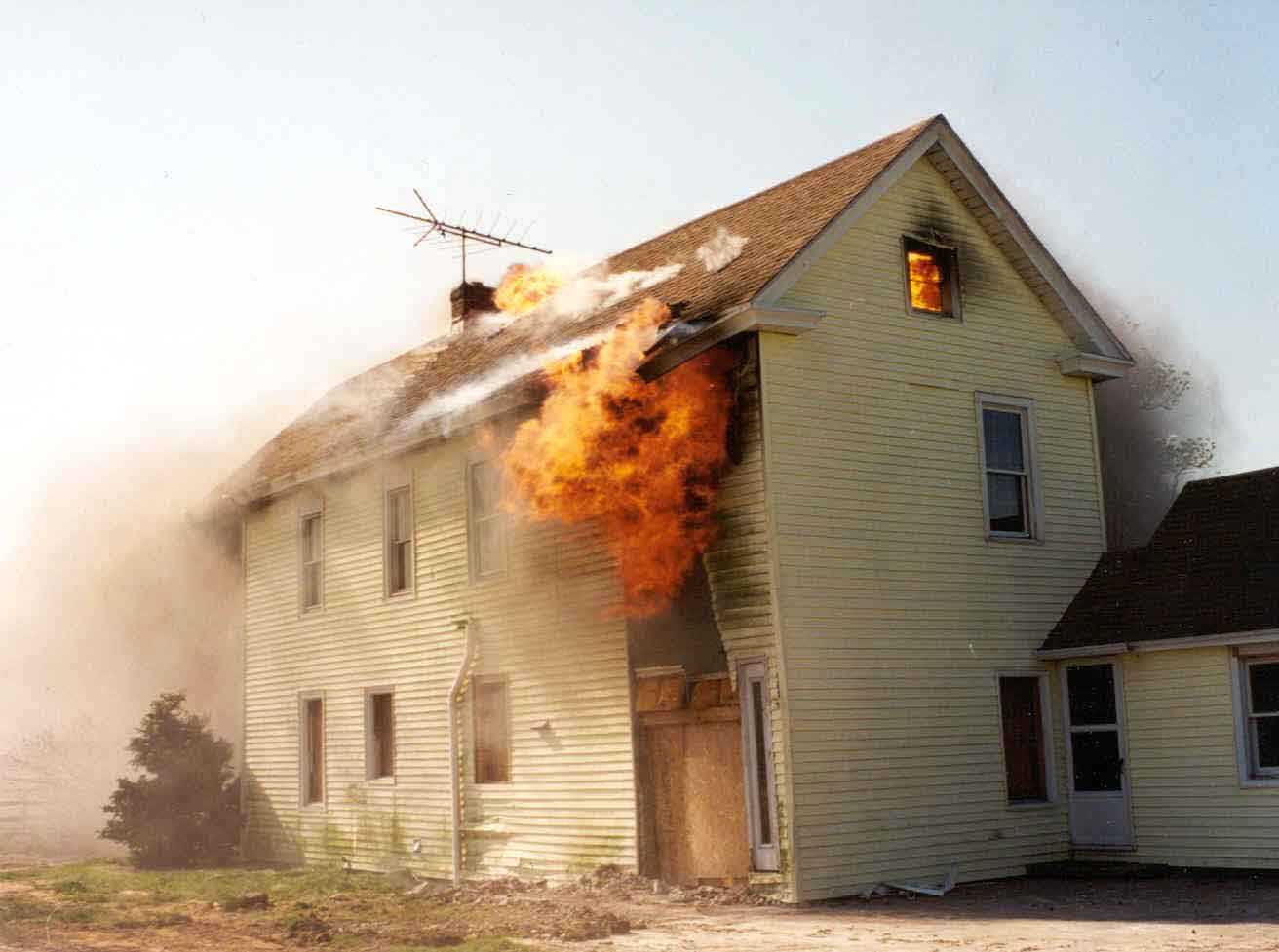
Photo courtesy of the Delaware State Fire Marshal's Office.
Incident Site
INTRODUCTION
On April 30, 2000, a 27-year-old, male volunteer Assistant Chief (the victim) died while performing a controlled-burn training evolution. The victim and three other fire fighters entered the attic of a 2½-story farm house to perform the last training evolution. The victim and fire fighters ignited the attic and the victim failed to exit. The National Institute for Occupational Safety and Health (NIOSH) was notified of this incident on May 1, 2000, by the United States Fire Administration. On June 5-6, 2000, two safety and occupational health specialists investigated this incident. Meetings were conducted with the State Fire Marshal's Office, a representative from the National Volunteer Fire Council, and the Chief and fire fighters from the volunteer fire department. Investigators obtained a copy of the department's standard operating procedures (SOPs), the victim's training records, department training guidelines, state burn regulations, the victim's death certificate, and drawings and photographs of the incident scene. The department's SOPs were reviewed and appeared to be sufficient. A site visit was also conducted by the investigators. The fire department involved in the incident serves a population of approximately 10,000 in a geographical area of 64 square miles. The department is comprised of 50 fire fighters and 5 ambulance personnel which respond out of one station. The fire department places all new fire fighters on probation until they complete the Delaware State Fire School courses entitled Basic Fire Fighting Skills (24 hours) and Vehicle Rescue Course (24 hours). Before completion of the fire fighters' second year of membership, they must complete Structural Fire Fighting Skills (24 hours), Hazardous Materials Response Skills (24 hours), and complete a department orientation with the Fire Chief or department training officer. Annual refresher training is provided by the department. The victim's training records were reviewed and appeared to be sufficient. The victim had 6 years of combined experience as an Assistant Chief and fire fighter.
The structure involved in the incident was a 2½-story farm house with an attic. The structure was built in the late 1800s. The foundation was constructed of masonry block and the structure was ballooned framed using 2- by 4-inch lumber. The roof system was raftered using 2- by 4-inch lumber and covered with ½-inch plywood. The exterior roof was comprised of cedar shake shingles overlapped with two layers of asphalt shingles. Vinyl siding covered the exterior walls and the insulation was fiberglass. The structure was approximately 3,000 square feet including the area of the attic.
INVESTIGATION
On April 16, 2000, the volunteer Fire Chief met with the owner of a 2½-story farm house to discuss the possibilities of completing a controlled-burn training evolution involving the house. Following their discussion, the owner of the farm house granted the volunteer Chief permission to burn the structure and complete the training. On the same day, the Chief completed a structural evaluation to determine the structure's stability, did an interior walk through to determine the combustibles, and set up a date to complete the burn. The Chief stated that the farm house appeared to be structurally sound and was nearly empty during his evaluation. The Fire Chief applied for a state burn permit, which was approved.
On April 30, 2000, the volunteer fire department prepared to complete a controlled-burn training evolution. At 0700 hours, the following volunteer fire fighters gathered at the station to discuss their plan of action: the Chief, Assistant Chief (the victim), Captain, Second Rescue Lieutenant, Chief Engineer, Third Assistant Chief Engineer, and four fire fighters. The Chief informed the fire fighters that they would be setting up water curtains (a stream of water projected through a pipe to cool exposures), laying hoselines, completing four live burn evolutions (training exercises) using gasoline-powered chain saws that a sales representative was providing, and then burning the rest of the structure from top to bottom to complete the training. After the briefing, fire fighters responded to the burn site in two of the department's engines (Engine 3 and Engine 4), their tanker truck, and by personal vehicles. All of the fire fighters and a sales representative (also a volunteer fire fighter from a mutual-aid company) arrived on the scene at 0730 hours and began setup. They laid out four water curtains to protect existing trees and the driveway, laid out hoselines to supply the water curtains, and laid out two additional 1¾-inch hoselines (one was to be used in the training and the other was to protect the northwest exposure when they completed the final burn [see Diagram 1]). Upon completing the setup, the Chief ordered all fire fighters to walk through the house on their own to familiarize themselves with the layout and design.
In preparation to start the training evolutions, the Fire Chief, victim, and the Second Rescue Lieutenant entered the first floor front door and placed hay in the living room, next to the walls (see Diagram 1). The Chief exited the house and briefed the fire fighters who would be performing the training. He told the fire fighters to enter through the front door, search for the fire, and knock it down. The Chief then ordered the victim to exit the structure and wait to reenter with the fire fighters performing the training, to evaluate their performance. The victim was equipped with full turnouts and a new self-contained breathing apparatus (SCBA), which the sales representative provided for him to use. Note: The sales representative had briefed the victim on the SCBA and the victim was familiar with its operation. The victim had also used this SCBA prior to this day. The Second Rescue Lieutenant was ordered by the Chief to start the first fire. Using a 1-gallon sprayer, filled with diesel fuel, the Second Rescue Lieutenant sprayed the hay and used a flare to start the fire. The Second Rescue Lieutenant then exited the structure. The fire fighters and the victim entered the structure in full turnouts and SCBAs. They stretched a 1¾-inch hoseline inside the structure, found the fire, and immediately knocked it down, completing the first evolution. Three additional evolutions were completed in the same manner. The evolutions lasted approximately 1 hour and the fire fighters then took a break. After the break, the sales representative provided the department with a new gasoline-powered chain saw to use for training. The fire fighters, including the victim, performed a series of cuts on the exterior of the house. Fire fighters then took the chain saw they were testing, along with one of their own chain saws, inside the house and proceeded to the attic to cut holes in the attic floor. They cut two holes, 2 feet by 2 feet, directly under a window on the west wall and a window under the south wall (see Diagram 3). Note: The fire fighters made the cuts as a part of their testing. The attic space was approximately 1,000 square feet with 4-foot knee walls around the perimeter. The ceiling was approximately 8 feet in height and sloped with the roof pitch. Completing the cuts in the attic, the fire fighters went back to the first floor to cut additional holes in the floor. The fire fighters met up with the Chief who was knocking free the base of the two chimneys with a sledge hammer (see Diagram 1). He was freeing the chimney bases because he wanted the chimneys to collapse as the house burned. As the fire fighters cut holes in the floor, the victim, along with the Second Rescue Lieutenant, the Third Assistant Chief Engineer, and a fire fighter, entered the first floor and met up with the Chief. The victim was wearing complete turnouts with a SCBA and the others were just wearing turnouts. The Chief told them to go the attic and prepare it for the last burn. He told the victim to start spraying diesel fuel on the south wall and work his way back to the stairs, spraying it last. He then checked the victim's SCBA air gauge and told the victim that it was half full. The victim, who was equipped with the diesel fuel sprayer, the Second Rescue Lieutenant, Third Assistant Chief Engineer, and a fire fighter proceeded to the attic at approximately 0920 hours. The victim walked across the attic and surveyed the layout before returning to the steps and met back up with the others. The victim noticed that cardboard boxes, papers, a Christmas tree, and clothing were spread throughout. Due to the inexperience of the fire fighter, the victim told him to return to the first floor and exit. The victim and Second Rescue Lieutenant walked over to the south wall of the attic as the Third Assistant Chief Engineer entered a 12-foot by 8-foot playroom on the west side (see Diagram 3). Starting on the south wall, the victim sprayed the diesel fuel on the walls and debris, making his way back around by the chimney in the middle of the floor (see Diagram 3). The Second Rescue Lieutenant struck a flare and started lighting the areas the victim had sprayed. The victim met with the Third Assistant Chief Engineer in the playroom (near the exit) and told him to strike a flare and ignite the room. Soon after, the Rescue Captain reached the attic floor. He stated that there was a breeze coming through the playroom, which he thought was coming through the playroom window. The Second Rescue Lieutenant confirmed that both windows on the south and west walls in the playroom were open before they started the final burn. The victim returned to the middle of the attic as the Third Assistant Chief Engineer lit various objects (e.g., a small, dried out shrub, a poster hanging on the ½-inch particle board wall, a piece of flex duct, and debris on the floor). The Engineer stated that the room quickly became engulfed in flames and the heat forced him to exit and shut the room's door. The Third Assistant Chief Engineer met back up with the victim and stated that he could see a small fire in the south section of the attic. The Third Assistant Chief Engineer told the victim that the playroom was lit and the fire was intensifying. The two of them remained in the middle of the attic before the Third Assistant Chief Engineer noticed that the smoke was starting to get heavy and the heat was intensifying. The Rescue Captain noticed the same conditions and exited down the stairs to the second floor. At approximately 0930 hours, the Third Assistant Chief Engineer exited the attic and met up with the Chief on the first floor, relating to him that the attic was lit. The Second Rescue Lieutenant finished igniting the south section of the attic and noticed the victim was spraying additional fuel on the small fires in the same section. The Second Rescue Captain stated that the smoke was banking down and there was moderate heat in that area. He told the victim that they should exit and he started toward the stairway. The victim told him that he was going to stay in the attic a little longer. Note: The victim was wearing full turnouts and a SCBA. It was noted in the investigation that this was the first time the victim had worn a SCBA while igniting a controlled burn. The Second Rescue Lieutenant noticed the heat intensifying and the smoke was banked to the floor as he made his way closer to the stairway. He went halfway down the stairs before stopping, exposing his back to the playroom area, and yelled to the victim. He told the victim that he should exit because it was getting worse by the stairs. Immediately after yelling to the victim, the Second Rescue Lieutenant was forced down the stairs by a sudden blast of heat. The heat came from the direction of the playroom. The Second Rescue Lieutenant made it down the stairs and onto the second floor where he met the Rescue Captain (see Diagram 2). The Second Rescue Lieutenant was coughing from the smoke and told the Rescue Captain that the victim was still upstairs and he (the Second Rescue Lieutenant) was exiting. The Rescue Captain saw heavy, black smoke followed by flames, emit from the attic stairway. He stated the he heard three loud thumps from the attic floor and then exited the house due to the heat and smoke. The Second Rescue Lieutenant told the Chief that the victim was not with him and he did not know where he was. After a short search, they could not locate the victim and determined he was still inside. The Chief noticed heavy fire inside the playroom window and the south side window of the attic (see Photo). The Chief radioed dispatch and requested mutual-aid companies to respond. The Rescue Captain and the Third Assistant Chief Engineer pulled a 1¾-inch hoseline to the south side and applied water to the south side attic window. The sales representative also grabbed a 1¾-inch hoseline and applied water to the attic's playroom window from the west side. The Chief ordered the Captain and the Chief Engineer to throw a ladder to the second floor roof, which covered the south side porch. The Second Rescue Lieutenant donned his SCBA, grabbed the 1¾-inch training hoseline, and stretched it up the ladder. At approximately 0941 hours, the Second Rescue Lieutenant pulled the hoseline through an open window and stretched it halfway up the attic stairs. The hoseline was only 150 feet in length and would not reach up to the top of the stairs. The Second Rescue Lieutenant applied water from the bottom of the stairs to heavy fire in the playroom section of the attic before running out of air. After donning their SCBAs, the Captain and a fire fighter climbed the ladder and entered the same window on the second floor. As the Second Rescue Lieutenant exited, he passed the Captain by the base of the stairs. The Captain reached the nozzle of the same hoseline and applied water to the playroom area. Shortly after the fire fighter met up with the Captain, the Captain dropped the nozzle and entered the attic area to search for the victim. The fire fighter grabbed the nozzle and opened it, attempting to hold back the fire as the Captain searched. The Captain located the victim in the middle section of the attic. The victim was found on his back with his head facing northwest and his feet facing southeast. The Captain attempted to pull him to the attic stairway, but was unsuccessful. The Captain noticed heavy fire throughout the attic and stated that the heat was very bad. He attempted to move the victim a second time and again was unsuccessful. After the second attempt, the Captain had to exit the attic due to the extreme heat, fire conditions, and low air. The Captain stated that the victim was badly burned and was unconscious. The fire fighter manning the hoseline on the attic stairs also exited due to low air. The fire fighters all exited onto the second floor porch roof (see Diagram 2). The Captain related the victim's condition to the Second Rescue Lieutenant and the Chief, who was on the ground. The Second Rescue Lieutenant changed his air bottle, reentered the second floor window, and proceeded up the attic stairs to search for the victim. The Second Rescue Lieutenant stated there was still heavy fire and a lot of heat. He entered the attic area and located the victim approximately 10 feet from the stairs. In an attempt to remove him, he grabbed the victim's SCBA straps, pulled, and they broke. The Second Rescue Lieutenant's low air alarm then sounded which forced him to exit. He exited onto the second floor's porch roof when the Chief ordered all fire fighters out of the house. The mutual-aid companies arrived on the scene and took over operations. The operation was then declared as a recovery and the volunteer company was relieved from their duties. Shortly after the mutual-aid companies took over, the attic roof collapsed, pinning the victim underneath the debris. The fire was extinguished and the mutual-aid companies completed the recovery process. The victim was pronounced dead on the scene.
CAUSE OF DEATH
The death certificate listed the cause of death as asphyxiation and thermal burns. The victim's carbon monoxide level was listed at 41%. NOTE: Because of several factors-the length of time the victim was exposed to heat and fire, the collapsed debris, and the severity of the damage to the SCBA-it is unclear if the victim's SCBA facepiece was removed, SCBA hoselines melted, or if the SCBA malfunctioned. Due to the condition of the SCBA unit, no further evaluation could be completed. The SCBA was new and the victim had been using it prior to this incident. No problems with the SCBA were reported by the victim in the past or throughout the entire training operation.
RECOMMENDATIONS/DISCUSSION
Recommendation #1: Fire departments should ensure that flammable or combustible liquids as defined in NFPA 30 not be used in live fire training.1, 2
The National Fire Protection Association standard 1403, 2-3.3, notes that the use of flammable or combustible liquids, as defined in NFPA 30, shall not be permitted for use in live fire training evolutions in acquired structures. Additionally, the NFPA notes that fuel materials shall be used only in the amounts necessary to create the desired fire size. Pressure-treated wood, rubber, plastic, and straw or hay treated with pesticides or harmful chemicals shall not be permitted to be used. The fuel load shall be limited to avoid conditions that could cause an uncontrolled flashover or backdraft.
Recommendation #2: Fire departments should ensure that proper ventilation is in place before a controlled burn takes place.2
The Delaware Fire Prevention Commission regulation 3-3.3 regarding live fire training states that adequate ventilation openings shall be made in the roof. Regulation 3-3.4 also notes that roof ventilation openings that are normally closed, but can be opened in the event of an emergency, may be utilized. These may consist of panels or hinged covers. Proper ventilation should be in place before ignition occurs to release heat and gases that can build up and possibly cause a flashover or backdraft.
Recommendation #3: Fire departments should ensure that fires not be ignited in any designated path of exit. 1
The National Fire Protection Association standard 1403, 2-4.15, notes that fires shall not be ignited in any designated exit paths. In the event that the ignition officer or other fire fighters would need to exit, the path should be clear of any debris, obstacles, or fire.
Recommendation #4: Fire departments should ensure that an evacuation signal is communicated to all fire fighters prior to ignition.1, 2
The National Fire Protection Association standard 1403, 2-4.10 and A-2-4.10, notes that an evacuation signal shall be demonstrated to all participants prior to the ignition of live fire training evolutions. When an evacuation signal is communicated, all participants should be instructed to report to a predetermined location for a roll call. Instructors should immediately report any personnel not accounted for to the Incident Commander or the instructor-in-charge. Examples of an evacuation signal that could be used include a whistle, apparatus air horn, or high-low electronic siren.
Recommendation #5: Fire departments should ensure that a building evacuation plan is in place and all fire fighters are familiar with the plan.1, 2
The National Fire Protection Association standard 1403, 2-4.10, and the Delaware Fire Prevention regulation 3-7.3 notes that a building evacuation plan shall be established and fire fighters should conduct a walk-through to familiarize themselves with the structure. In the event that an evacuation takes place, fire fighters should have knowledge of all exits and a predetermined location to meet for a roll call.
Recommendation #6: Fire departments should ensure that a method of fireground communication is established to enable coordination among the incident commander and fire fighters.1
The National Fire Protection Association standard 1403, 2-4.9, notes that communication shall be established between the incident commander and fire fighters performing any interior operations, sector leaders, and the safety officer. Proper communication is a must at any incident site. Portable radios should be used to keep all personnel on the scene in communication with the incident commander.
Recommendation #7: Fire departments should ensure that a safety officer be appointed for all live fire training.1, 2
A safety officer should be appointed by the authority having jurisdiction for all live fire training evolutions. The safety officer should have the authority, regardless of rank, to intervene and control any aspect of the operations when, in his or her judgement, a potential for an unsafe condition exists. The safety officer should provide for the safety of all persons on the scene including students, instructors, visitors, and spectators. The safety officer shall not be assigned any other duties that interfere with safety responsibilities.
Recommendation #8: Fire departments should ensure that each fire fighter be equipped with full protective clothing and a SCBA.1, 2
Each participant in a training evolution should be equipped with full protective clothing and self-contained breathing apparatus. All participants should be inspected by the safety officer prior to entry into a live fire training evolution to ensure that the protective clothing and SCBA are being worn properly and are in serviceable condition. Although it is recommended that all fire fighters involved in live fire training evolutions be equipped with full protective equipment and a SCBA, fire fighters must still evaluate conditions at all times and beware of the possibilities that the protective equipment can give a false impression of temperatures and conditions.
Recommendation #9: Fire departments should ensure that backup personnel are standing by with equipment, ready to provide assistance or rescue.1, 2
Backup personnel, trained and equipped, should be on the scene of a live fire training evolution in case an emergency would occur. The backup personnel, also known as a rapid intervention team or crew, should stand by with a backup hoseline and other necessary equipment to ensure adequate protection for personnel on training attack lines. The backup hoseline should be long enough to reach any interior component of the structure.
Recommendation #10: Fire departments should ensure that only one person be assigned as the "ignition officer" and it not be a fire fighter participating in the training.1
The National Fire Protection Association standard 1403, 2-4.24, notes that one person shall be designated as the "ignition officer" to control the materials being burned and the ignition officer shall not be a fire fighter participating in the training.
Recommendation #11: Fire departments should ensure that exterior fire attack is at a minimum during search and rescue.3
Once search and rescue operations are in place, fire departments should ensure that the fire fighters completing the search and rescue are not placed in danger by the fire attack. It is a complicated procedure to determine, from outside a structure, the position of the fire fighters completing the search and rescue operations in the interior. If an exterior fire attack is being performed while the interior search and rescue operations are taking place, there is a possibility that the fire could shift and place the interior fire fighters in an unsafe position. Additionally, the use of an exterior hoseline placing water through a window could possibly cause a collapse, placing the interior fire fighters in danger. Command and operations must always be in communication at all times on the fireground to eliminate confusion of tactics.
Recommendation #12: Fire departments should ensure that fire fighters who enter a hazardous condition enter as a team of two or more.4
The National Fire Protection Association (NFPA) recommends that four persons (two in and two out), each with protective clothing and respiratory protection, is the minimum number essential for the safety of those performing work inside a structure. The team members should be in communication with each other through visual, audible, or electronic means to coordinate all activities and to determine if emergency rescue is needed. Also, the recently promulgated standard by the Occupational Safety and Health Administration (29 CFR 1910.134) states that when two or more workers enter an immediately dangerous to life and health (IDLH) atmosphere, such as the atmosphere commonly found in structural fire fighting, two will remain on the outside and maintain visual or voice contact to assist in emergency rescue activities.
REFERENCES
1. NFPA 1403, Standard on live fire training evolutions. 1997 ed., Quincy, MA: National Fire Protection Association.
2. Delaware Fire Prevention Commission [1997]. Regulations for live fire training. Dover, DE: Delaware State Fire School.
3. Coleman J [1997]. Incident management for the street-smart fire officer. Saddle Brook, NJ: Fire Engineering.
4. 29 Code of Federal Regulations 1910.134, OSHA Respirator Standard.
INVESTIGATOR INFORMATION
This incident was investigated by Frank C. Washenitz II and Nancy Romano, Safety and Occupational Health Specialists, Division of Safety Research, Surveillance and Field Investigations Branch, NIOSH.
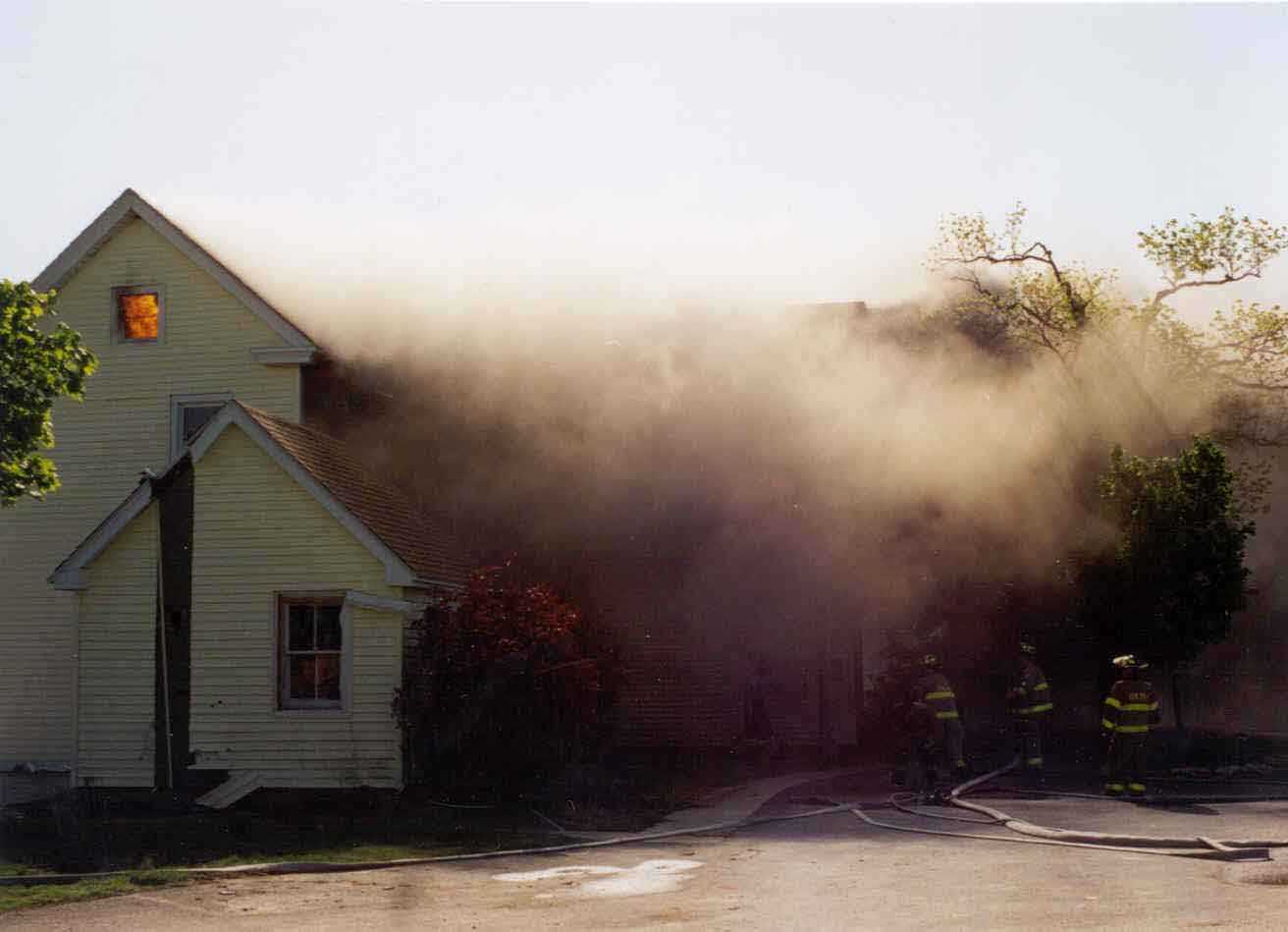
Photo courtesy of the Delaware State Fire Marshal's Office.
Photo. Structure Involved in This Incident
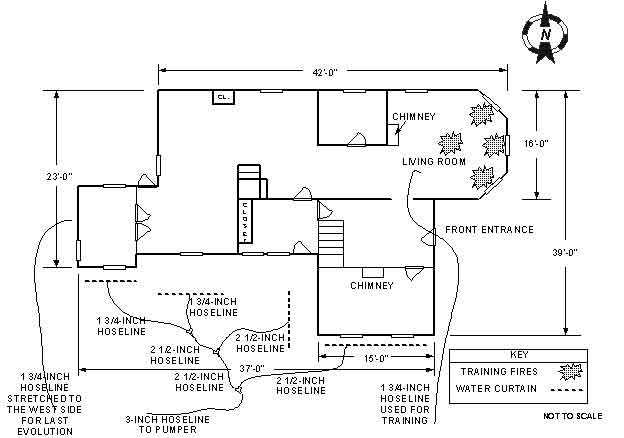
Diagram 1. First Floor Layout
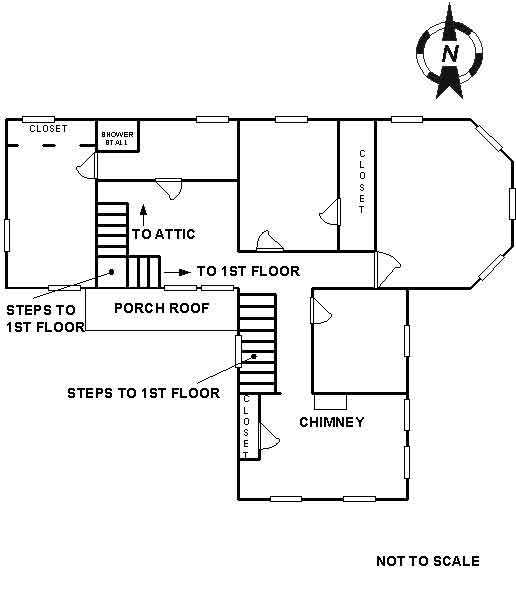
Diagram 2. Second Floor Layout
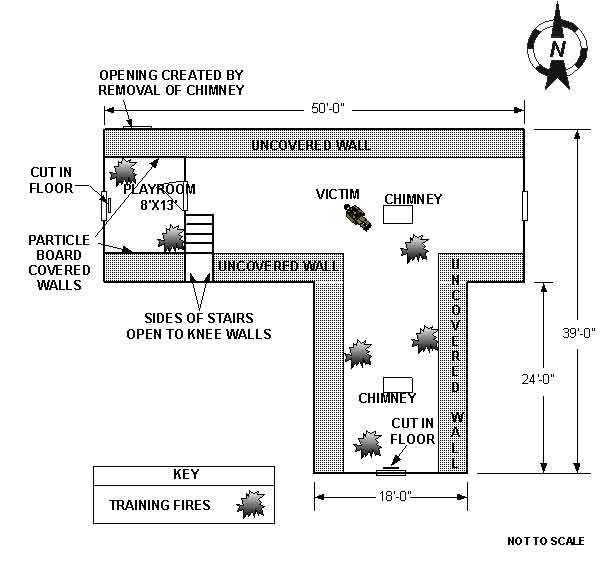
Diagram 3. Attic Layout
This page was last updated on 10/10/01
- Page last reviewed: November 18, 2015
- Page last updated: October 15, 2014
- Content source:
- National Institute for Occupational Safety and Health Division of Safety Research


 ShareCompartir
ShareCompartir